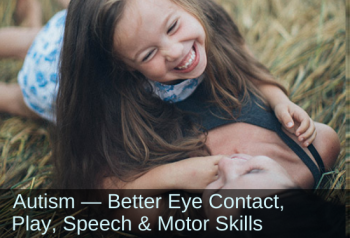Autism, Eye Contact, Speech, Gross and Fine-Motor Skills
Submitted by Jennifer Davis, COTA/L

|
Before
|
After
|
|
Poor eye contact
|
Can now focus on tasks; for example, looks at zipper on coat and grabs each side of the coat with both hands independently
|
|
Non-verbal
|
Using more spontaneous single word utterances within context
|
|
Often had mouth open
|
Has started getting more lip closure
|
|
Poor grasp
|
Much more mature pencil grasp
|
I am an occupational therapy assistant, and I have worked with Maggie in a public school setting, for the past 3 years. She is now 6. Maggie has significant delays in many areas. She is non-verbal but can follow very simple commands at times. She has a diagnosis of autism, in addition to, a diagnosis of nystagmus, tonic upgaze, and extreme farsightedness. Maggie was delivered naturally, 2 weeks early. She underwent feeding therapy as an infant, and still has a tendency to overstuff her mouth if she’s not watched. According to Maggie’s mom, she had significant delays in meeting all of her motor milestones.
I wasn’t sure how Maggie would respond to the rhythmic movements, so I started doing [the Brain Tune up from the Brain and Sensory Foundations course] passively with her, in supine. During this time, I would use Heart Connection, to try to make the experience as positive as possible for the both of us. She tolerated all the movements better than I thought she was going to and seemed to prefer RM 2a and RM4, using a fast pace. After the first week, Maggie was able to stay with RM1 for much longer and tolerated getting into RM3 position for the first time. After 3 weeks, she was able to tolerate RM1 and RM3 for several minutes at a time.
I initiated original play, once she was able to tolerate doing all of the rhythmic movements, to try to get her to engage and really play with me. To my joyous surprise, she slowly smiled, then giggled. After a month of doing all the rhythmic movements and original play, Maggie was using more spontaneous single word utterances within context. Her eye contact improved to the point where she looked at her zipper on her coat and grabbed each side of her coat with both hands independently. Her grasp pattern improved and she began roughly tracing letters.
After a month and a half, Maggie was able to actively take over RM1 and RM3 for approximately 20 repetitions, and she stopped grinding her teeth.
Next, I worked on Maggie’s hand and foot reflexes [from the Brain and Sensory Foundations course].
I thought it would be good to start with passive integration movements at the hands and feet so she could see what was going on, and feel safer being able to see what was being done. When I checked her hand reflexes, the grasp, palmar, and Babkin were all unintegrated. When I checked her foot reflexes, both plantar and Babinski, were unintegrated. We started doing the grasp and palmar/Babkin isometric activities passively, and the first thing I noticed was that Maggie really looked at her hands as I was performing the isometric activity. It was almost as if it was the first time she realized she had hands that connected to her body.
We also began doing the plantar and Babinski isometric activities passively, which she tolerated really well. Again, she looked at both of her feet and maintained visual attention with her feet for the duration of the movement activity. After 2 weeks of working on hand and feet reflexes [from the Brain and Sensory Foundations course], Maggie was using a much more mature pencil grasp with markers. She was able to start using a more advanced pair of scissors for cutting. She started getting more lip closure instead of having her mouth open all the time. After 3 weeks of performing the hand and foot isometric activities, Maggie was able to perform a 2 foot jump on a trampoline and on the floor, which was a physical therapy goal she had not met, for the past 3 years!
She also began to semi-actively start squeezing my finger/thumb herself during the grasp and palmar/Babkin isometric activities, and independently started opening her hands, taking a much more active role in the integration work.
The physical therapist that works with Maggie was so impressed with her progress, she began implementing the rhythmic movements into her therapy sessions with Maggie.
Edited, emphasis added


